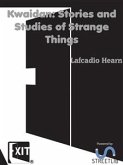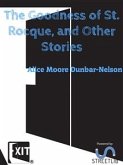THROUGH THE GAP
When thistles go adrift, the sun sets down the valley between the hills; when snow comes, it goes down behind the Cumberland and streams through a great fissure that people call the Gap. Then the last light drenches the parson's cottage under Imboden Hill, and leaves an after-glow of glory on a majestic heap that lies against the east. Sometimes it spans the Gap with a rainbow.
Strange people and strange tales come through this Gap from the Kentucky hills. Through it came these two, late one day—a man and a woman—afoot. I met them at the foot-bridge over Roaring Fork.
"Is thar a preacher anywhar aroun' hyeh?" he asked. I pointed to the cottage under Imboden Hill. The girl flushed slightly and turned her head away with a rather unhappy smile. Without a word, the mountaineer led the way towards town. A moment more and a half-breed Malungian passed me on the bridge and followed them.
At dusk the next day I saw the mountaineer chopping wood at a shanty under a clump of rhododendron on the river-bank. The girl was cooking supper inside. The day following he was at work on the railroad, and on Sunday, after church, I saw the parson. The two had not been to him. Only that afternoon the mountaineer was on the bridge with another woman, hideously rouged and with scarlet ribbons fluttering from her bonnet. Passing on by the shanty, I saw the Malungian talking to the girl. She apparently paid no heed to him until, just as he was moving away, he said something mockingly, and with a nod of his head back towards the bridge. She did not look up even then, but her face got hard and white, and, looking back from the road, I saw her slipping through the bushes into the dry bed of the creek, to make sure that what the half-breed told her was true.
When thistles go adrift, the sun sets down the valley between the hills; when snow comes, it goes down behind the Cumberland and streams through a great fissure that people call the Gap. Then the last light drenches the parson's cottage under Imboden Hill, and leaves an after-glow of glory on a majestic heap that lies against the east. Sometimes it spans the Gap with a rainbow.
Strange people and strange tales come through this Gap from the Kentucky hills. Through it came these two, late one day—a man and a woman—afoot. I met them at the foot-bridge over Roaring Fork.
"Is thar a preacher anywhar aroun' hyeh?" he asked. I pointed to the cottage under Imboden Hill. The girl flushed slightly and turned her head away with a rather unhappy smile. Without a word, the mountaineer led the way towards town. A moment more and a half-breed Malungian passed me on the bridge and followed them.
At dusk the next day I saw the mountaineer chopping wood at a shanty under a clump of rhododendron on the river-bank. The girl was cooking supper inside. The day following he was at work on the railroad, and on Sunday, after church, I saw the parson. The two had not been to him. Only that afternoon the mountaineer was on the bridge with another woman, hideously rouged and with scarlet ribbons fluttering from her bonnet. Passing on by the shanty, I saw the Malungian talking to the girl. She apparently paid no heed to him until, just as he was moving away, he said something mockingly, and with a nod of his head back towards the bridge. She did not look up even then, but her face got hard and white, and, looking back from the road, I saw her slipping through the bushes into the dry bed of the creek, to make sure that what the half-breed told her was true.









